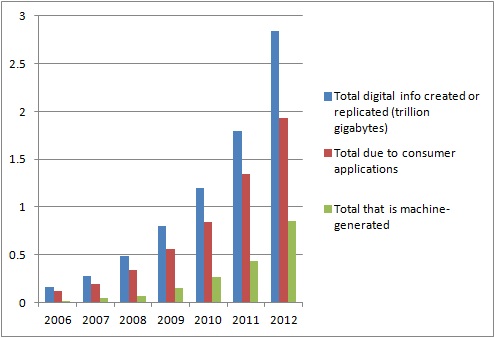Humans Generate Most of the World’s Data, but Machines Are Catching Up
A global proliferation of devices like the ones many manufacturers are showcasing at this week’s annual Consumer Electronics Show has made the number of bytes in the world balloon extremely rapidly. Since 2005, when analysts at market research firm IDC began publishing an annual estimate of all the bytes added to the “digital universe,” defined as “all the information created, replicated, and consumed in a single year,” the number has grown from 130 billion gigabytes to 2.8 trillion gigabytes in 2012. IDC’s latest projection is that by 2020 the number will reach 40 trillion.
Consumers have accounted for around 70 to 75 percent of that total each year so far—creating and consuming roughly 1.9 trillion gigabytes in 2012. Of the new data created by consumers in 2012, roughly 80 percent came from digital televisions, as shown in the chart below.
Data Created by Consumers in 2012, by Source

Source: IDC
While in absolute terms the amount of data created by consumers will continue to grow quickly, the pool of data generated by things like industrial machines, vehicles, medical devices, sensors, and security cameras is expanding faster. This is shown in the chart below. In 2012, according to IDC, “machine-generated” data represented 30 percent of all data created, up from 24 percent last year and 16 percent five years ago.
Digital Information Created or Replicated Annually

Source: IDC
The numbers show us that the world’s supply of what is commonly called “big data”—pools of analyzable and potentially useful digital information—is still relatively small. Much of the data generated by consumers, like that episode of your favorite sitcom saved on your DVR, isn’t very useful for analysis and is eventually deleted. More promising for big-data analysis are the readings from machines monitoring our world, from surveillance equipment and medical devices. And that’s just getting started.
Keep Reading
Most Popular
Large language models can do jaw-dropping things. But nobody knows exactly why.
And that's a problem. Figuring it out is one of the biggest scientific puzzles of our time and a crucial step towards controlling more powerful future models.
The problem with plug-in hybrids? Their drivers.
Plug-in hybrids are often sold as a transition to EVs, but new data from Europe shows we’re still underestimating the emissions they produce.
Google DeepMind’s new generative model makes Super Mario–like games from scratch
Genie learns how to control games by watching hours and hours of video. It could help train next-gen robots too.
How scientists traced a mysterious covid case back to six toilets
When wastewater surveillance turns into a hunt for a single infected individual, the ethics get tricky.
Stay connected
Get the latest updates from
MIT Technology Review
Discover special offers, top stories, upcoming events, and more.